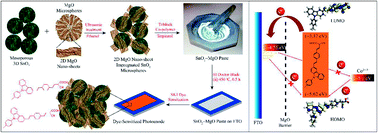Enhanced photovoltaic performance of meso-porous SnO2 based solar cells utilizing 2D MgO nanosheets sensitized by a metal-free carbazole derivative†
Abstract
Herein, we report the power conversion efficiency (PCE) of ∼3.71%, achieved in a mesoporous SnO2 based solar cell by introducing 15 wt% of 3D porous hierarchical MgO composed of 2D nanosheets by a simple sonochemical route followed by a mixing process, sensitized with a metal-free carbazole dye, namely, 2-cyano-3-(4-(2-(9-p-tolyl-9H-fluoren-6-yl)vinyl)phenyl)acrylic acid (i.e. SK1 dye). We have optimized the performance of solar cell devices with the addition of MgO and performed a comparative study on photovoltaic performances of the fabricated devices, such as SnO2–MgO with pristine SnO2, by employing two different redox mediators, namely, (I−/I3−) and [Co(bpy)3]2+/3+. We observed a significant improvement in the open circuit voltage (Voc) and fill factor (FF) for the SnO2–MgO based dye sensitized solar cell (DSSC) over the pristine SnO2 device, i.e. from 357 mV to 550 mV and from ∼38% to ∼50% respectively, wherein an ∼60% enhancement in PCE for the SnO2–MgO device as compared to bare SnO2 device using the redox mediator (I−/I3−) is achieved. Interestingly, in the case of cobalt tris(2,2′-bipyridyl) redox shuttle, we observed further improvement in the PCE value of the photovoltaic device by 74%, i.e. from ∼1% (pristine SnO2 device, redox mediator I−/I3−) to ∼3.71% (SnO2–MgO device). From electrochemical impedance spectroscopy (EIS) of the devices, we conclude that the charge transfer resistance at the SnO2–MgO/SK1/electrolyte interfaces is lower as compared to SnO2/SK1/electrolyte interfaces, which demonstrates faster charge migration across the interfaces and a slower electron–hole (e−–h+) recombination rate. It was observed that in the presence of MgO, the life time of photoinduced electrons in the conduction band (CB) of SnO2 microspheres increases to τe = 15.9 ms from 7.1 ms (for pristine SnO2 device), by employing [Co(bpy)3]2+/3+ as a redox shuttle, and thus resulting in higher values of open circuit voltage (Voc) and short circuit current density (Jsc). Therefore, hierarchical MgO not only improves the PCE of the photovoltaic devices by minimizing the leakage of trapped electrons in the conduction band level of SnO2/electrolyte interface but also provides more surface area for the adsorption of dye molecules.


 Please wait while we load your content...
Please wait while we load your content...